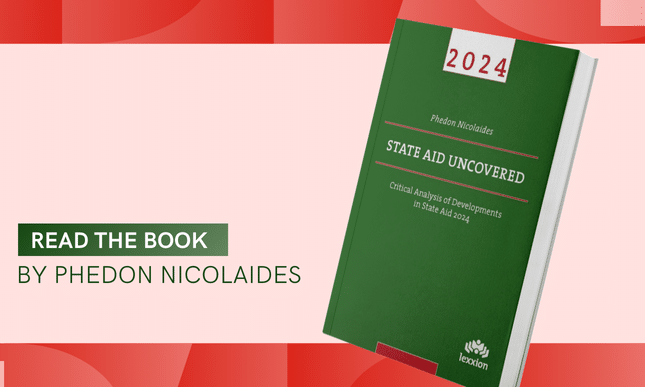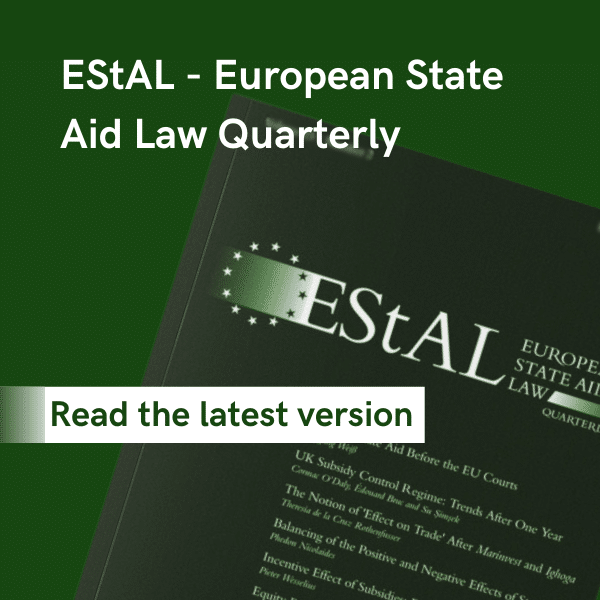
Introduction
This article reviews one of the first Commission decisions authorising state aid under the new Clean Industry State Aid Framework [CISAF]. It concerns an Italian measure that was originally notified to the Commission under the Temporary Crisis and Transition Framework, but then re-notified in July 2025 under CISAF after CISAF was adopted by the Commission in June 2025. The Commission, in decision SA.118614, approved the Italian measure in October 2025.[1]
The aid with a budget of EUR 61.5 million supports undertakings in the region of Emilia Romagna. An almost identical Italian measure with a larger budget of EUR 219 million was approved a month later for the support of undertakings in the region of Lazzio [SA.120013].[2] The very first Commission decision approving a measure based on CISAF was adopted in August 2025 for a French measure supporting the construction and operation of three wind farms off the cost of Brittany [SA.115764].[3] While the aid in the two Italian measures conformed with section 6 of CISAF, the French measure complied with section 4 concerning State Aid to accelerate the rollout of clean energy. Its budget is also much larger, estimated at EUR 11.3 billion over a 20-year period or EUR 567 million per year.
As will be seen later on, the assessment of the Commission of the Italian measure is rather light and based on the presumptions that are built in CISAF.
The objective of the measure is to incentivise, through direct grants, subsidised interest rates and loans, investments in sufficient manufacturing capacity of clean technologies. This kind of aid is now allowed under section 6 of CISAF.
As mentioned above, the estimated budget is EUR 61.5 million. It will be financed by the European Regional Development Fund [ERDF] [ERDF money will also finance the measure for the Lazzio region]. This means that the measure must also conform with the structural fund rules such as the Common Provisions Regulation [Reg 2021/1060] and the ERDF Regulation [Reg 2021/1058].
The measure is open to both SMEs and large enterprises, all of which, however, must be active in the Emilia-Romagna region.
Sectorial scope
The measure seeks to support specific sectors. “(11) The measure aims at incentivising investment projects that add manufacturing capacity for:
- the production, including with secondary raw materials, of the final products listed in Annex II CISAF; and/or
- the production, including with secondary raw materials, of the main specific components listed in Annex II CISAF; and/or
- the production of new or recovered related critical raw materials necessary for the production of the final products or main specific components defined under points (a) and (b).”
Eligible expenditure
The eligible costs are all investment costs into tangible and intangible assets which are necessary either for the production or the recovery of the materials listed above.
In addition, the measure stipulates that “(13) intangible assets must:
- remain associated with the area concerned and must not be transferred to other areas;
- be used primarily in the relevant production facility receiving the aid;
- be amortisable;
- be purchased under market conditions from third parties unrelated to the buyer;
- be included in the assets of the undertaking that receives the aid; and
- remain associated with the project for which the aid is awarded for at least five years (or three years for SMEs).”
Maximum aid intensity and aid amount
In line with section 6 of CISAF, “(14-15) the aid intensity cannot exceed 15% of the eligible costs and the aid amount cannot exceed EUR 150 million per project in Italy. However, for investments in assisted areas designated in the applicable regional aid map for Italy in accordance with Article 107(3)(c) TFEU (‘c’ areas), the aid intensity can be increased to 20% of the eligible costs and the aid amount cannot exceed EUR 200 million per project in Italy. … For investments made by small enterprises, the aid intensities … can be further increased by 20 percentage points and for those investments made by medium-sized enterprises, the aid intensities can be increased by 10 percentage points.”
Beneficiary undertakings must invest at least 25% of the eligible costs, through own resources or by external financing, in a form that is free of any public support. At this point footnote 14 explains that public support includes “subsidised loans, public equity-capital loans or public participations which do not meet the market investor principle, State guarantees containing elements of aid, or public support granted within the scope of the de minimis rule.” However, “funding by the EIB and/or the EIF (at own risk and from own resources) for the investment project, up to 12.5% of the eligible costs, will be accepted as financial contribution for the purpose of this recital.”
The reference to 12.5% is puzzling. It is not specified in the Commission decision how the 12.5% threshold was derived or from where it originated. It is, however, clear that EIB/EIF funding may not exceed 50% of the own resources committed by the beneficiary undertakings.
Beneficiary undertakings must also maintain the investment in the region for at least five years, or three years for SMEs, after the completion of the investment. The decision clarifies that “(19) such a commitment must not prevent the replacement of plant or equipment that has become outdated or broken within this period, provided that the economic activity is retained in the area concerned for the minimum period. However, no further aid can be awarded to replace that plant or equipment.”
As is the Commission’s standard practice, the decision explicitly prohibits relocation of economic activity from one EEA region to another. “(20) Aid cannot be granted to facilitate the relocation of production activities within the EEA. For this purpose, beneficiaries must confirm that, in the two years preceding the aid application, no relocation has taken place to the establishment in which the aided investment is to take place and commit not to carry out such relocation up to a period of two years after completion of the investment.”
As may be recalled, CISAF [point 15(j)] defines relocation as follows: “Relocation means a transfer of the same or a similar activity or part thereof from an establishment in one contracting party to the EEA Agreement (‘initial establishment’) to the establishment in which the aided investment takes place in another contracting party to the EEA Agreement (‘aided establishment’). There is a transfer if the product or service in the initial and in the aided establishments serves at least partly the same purposes and meets the demands or needs of the same type of customers and jobs are lost in the same or similar activity in one of the initial establishments of the aid beneficiary in the EEA.”
Commission assessment
First, the Commission easily and briefly found the measure to constitute state aid. Then, it examined its conformity with the provisions of CISAF.
With respect to the positive condition that must be satisfied by compatible state aid, the measure in question was found to be capable of supporting the development of economic activities through investment in the production of critical raw materials that are needed for the manufacturing of clean technologies.
“(40) In that regard, the Commission notes that Italy intends to set up a measure to incentivise investments for the relevant clean technologies listed in recital (11). The measure falls within the scope of Section 6 of the CISAF, covering aid to ensure sufficient manufacturing capacity in clean technologies. Therefore, in line with the presumption enshrined in point 17 of the CISAF, the Commission considers that the measure aims at ensuring sufficient manufacturing capacity in clean technologies. As the categories of investments that it aims to incentivised, as described in recital (11), correspond to those listed in letters (a) to (c) of point 160 of the CISAF, the measure complies with that point as well.”
In addition, the Commission noted that i) the measure was a scheme [point 164 CISAF], that ii) it would not induce relocation and that iii) the investment would be maintained for 3/5 years [point 170 CISAF].
Then the Commission examined the presence of an incentive effect. Since the aid was to be delivered through a scheme, the Commission assessed only in an abstract manner compliance with the principle of incentive effect. It can also be seen below that the information required of Member States is pretty light.
“(45) According to point 18 of the CISAF, ‘State aid needs to have an incentive effect, meaning that it induces the beneficiary to undertake an investment or activity that it would not undertake, or would carry out in a restricted or different manner, absent the aid. Unless specified otherwise in this Communication, an incentive effect is presumed where the start of works on the project or activity only takes place after a written aid application by the beneficiary to the competent authorities’. Accordingly, under point 165 of the CISAF, ‘beneficiaries must apply for aid before the start of works and must provide the required information indicated in Annex III to this Communication to the Member State’.”
“(46) Under the measure, works on an individual investment can start only after submitting the application form for aid (recital (16)). Furthermore, beneficiaries must provide the information required in Annex III of the CISAF. Therefore, the measure complies with points 18 and 165 of the CISAF.”
“(47) According to point 19 of the CISAF, ‘for the investments and measures specified in this Communication, the Commission presumes that in the absence of the aid, beneficiaries would continue their activities without changes, provided that doing so would not entail a breach of Union law’. According to point 171 of the CISAF, ‘before granting the aid and on the basis of the information provided by the beneficiary as indicated in Annex III to this Communication, the granting authority must verify the concrete risks of the investment not taking place within the EEA’.”
“(48) The measure provides that the aid application will include all information required by Annex III of the CISAF. This includes a short description of the investment and a short explanation of the need for aid and its impact on the investment decision or location decision, including an explanation of the alternative investment or location decision if aid is not granted. The measure further provides that, before granting the aid and on the basis of the information provided by the beneficiaries in Annex III of the CISAF, the granting authority will verify the concrete risk that the investment will not be carried out in the EEA in the absence of aid (recital (17)). Therefore, the measure complies with points 19 and 171 of the CISAF.”
With respect to the negative condition of minimisation of the distortions caused by state aid, the Commission assessed, first, the need and appropriateness of the proposed aid.
“(53) According to point 26 of the CISAF, ‘any aid must be necessary, meaning that it must be targeted towards a situation where it can bring about a material development that the market alone cannot deliver, for example by remedying market failures in relation to the projects for which the aid is awarded. In view of the need to accelerate the eligible investments and activities under this Communication, the Commission considers that the market alone would not be able to sufficiently deliver the necessary level of investments or activities within the timeline necessary to achieve a clean, just and competitive transition. The Commission therefore presumes that measures falling within the scope of this Communication and complying with all conditions in the applicable sections are necessary’.”
“(54) The measure aims at incentivising investment projects that add manufacturing capacity for the relevant clean technologies listed in recital (11). Therefore, in line with the presumption enshrined in point 26 of the CISAF, there is a need for State intervention.”
“(55) According to point 27 of the CISAF, ‘public financial support may be required to incentivise necessary additional investments and that other policy instruments alone are not sufficient to achieve its goals. The Commission therefore presumes that State aid within the scope of this Communication is, in principle, an appropriate measure to incentivise the investments and activities eligible for aid provided all applicable conditions in the relevant sections are complied with. In addition, the choice of the aid instrument should be appropriate to the objective that the aid measure aims to achieve and likely to generate the least distortion of trade and competition. Provided that Member States comply with the conditions under this Communication, the Commission presumes that the aid instrument is also appropriate’. In addition, according to point 31 of the CISAF, ‘aid under this Communication can be granted in any form, including direct grants, tax advantages including tax credits and accelerated depreciation, subsidised interest rates on new loans or guarantees on new loans’”.
State aid must not just be necessary, it must also be proportionate.
“(59) According to point 29 of the CISAF, ‘[a]id is considered to be proportionate if the amount per beneficiary is limited to the minimum necessary to carry out the aided project or activity. […] The relevant sections of this Communication allow Member States to determine aid amounts administratively based on maximum aid intensities or by reference to the funding gap in line with the specific conditions provided in the applicable section’.”
“(60) Since aid under the measure is intended to ensure sufficient manufacturing capacity in clean technologies, Italy has determined the aid amounts and aid intensities based on the maximum aid amounts and intensities provided in points 167 and 168 of the CISAF (recitals (14) and (15)). Therefore, the measure is proportionate and complies with points 29, 167 and 168 of the CISAF.”
“(62) The measure establishes that the eligible costs are those in tangible and intangible assets required for the production or recovery of the goods listed in recital (11) (recital (13)). The measure further establishes that intangible assets comply with the requirements set out in point 166, second sentence, of the CISAF. Therefore, the measure complies with point 166 of the CISAF.”
“(63-64) According to point 169 of the CISAF, ‘to ensure that the investment is viable, the Member State must ensure that the aid beneficiary provides a financial contribution of at least 25% of the eligible costs, through its own resources or by external financing, in a form that is free of any public support’. … In that regard, the Commission notes that the contribution of the beneficiary to finance the investment project must be at least 25% of the eligible costs (recital (18)). Therefore, the measure complies with point 169 of the CISAF.”
State aid measures must avoid undue negative effects. This means that the distortions caused by an aid measure must be kept to the minimum necessary for the achievement of the objective [i.e. benefits] of the aid.
“(65) According to point 35 of the CISAF, ‘in view of the objectives pursued by the measures falling within scope of this Communication, the Commission presumes that such measures will not result in any manifestly negative effects on competition and trade in as far as they comply with all conditions in the applicable sections’. Furthermore, according to point 36 of the CISAF, ‘[a]id granted under this Communication cannot be conditioned on the relocation of an activity as such conditions would be harmful to the internal market.’ Accordingly, point 172 of the CISAF establishes that ‘the beneficiary has to: (a) confirm that in the two years preceding the application for aid, it has not carried out a relocation to the establishment in which the aided investment is to take place; and (b) commit not to carry out such relocation up to a period of two years after completion of the investment […]’.”
“(66) The Commission notes that any negative effects of the measure will be limited to the minimum in view of the need to ensure sufficient manufacturing capacity in the clean technologies listed in recital (11), which enhance the European capacity for net-zero technologies and their key components.”
“(67) Therefore, in line with the presumption in point 35 of the CISAF, any negative effects of the measure on competition and trade will be limited to the minimum.”
Conclusion
On the basis of the above analysis, the Commission found that the positive effects of the Italian measure outweighed the potential negative effects and, therefore, authorised the aid.
[1] The full text of the Commission decision can be accessed at:
https://ec.europa.eu/competition/state_aid/cases1/202543/SA_118614_41.pdf
[2] The Commission decision can be accessed at:
https://ec.europa.eu/competition/state_aid/cases1/202545/SA_120013_30.pdf
[3] The Commission decision can be accessed at:
https://ec.europa.eu/competition/state_aid/cases1/202535/SA_115764_142.pdf



